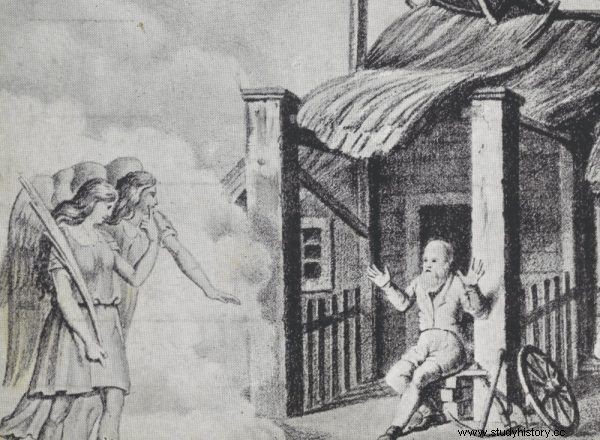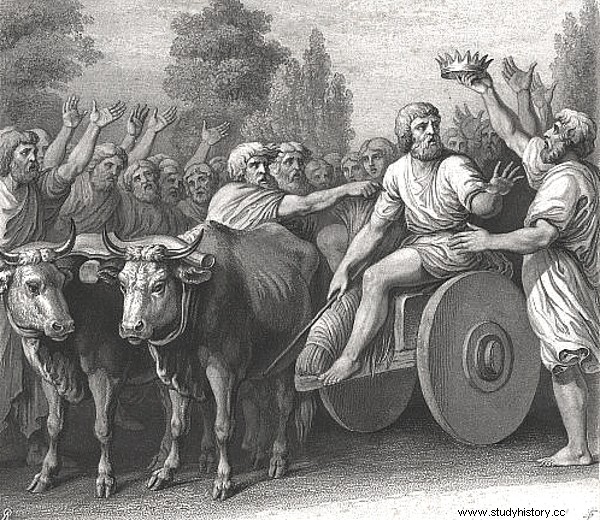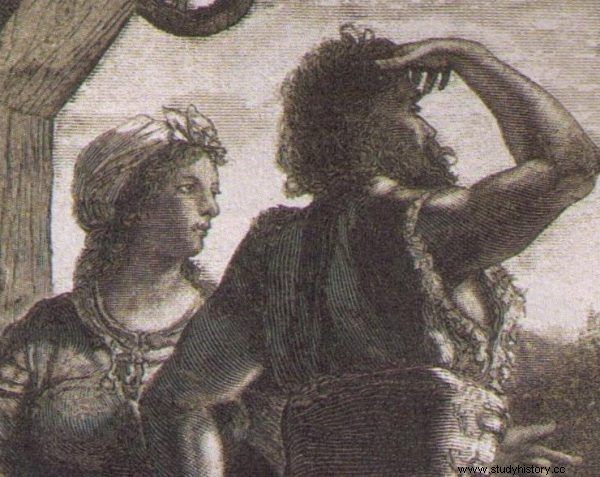It was he who was to start the dynasty that created the Polish state. However, did the legendary son of Piast and Rzepicha really exist, or was he just a figment of the chronicler's imagination? To this day, historians have been puzzled over this, and writers have created new visions of the fate of Siemowit Piastowic.
Siemowit was mentioned in his chronicle by Gall Anonim as the alleged ancestor of the Piast state. He certainly did not have first-hand information, as this work was created only about 150 years after the baptism of Mieszko I. What, then, did the chronicler have to say about the legendary rulers of Poland?
According to Anonim, it was Siemowit, and later Lestek and Siemomysł, the first dukes from the Piast dynasty, before Mieszko and the baptism of the state came. Siemowit was actually predestined for the role of a patriarch. His name means "leader of the family." The word "semja" in the language of the ancient Slavs is "family", and the suffix "wit" means "lord", "ruler".
Wonderfully marked
According to the chronicler's account, the legendary founder of the dynasty was born in the poor family of the plowman Piast and his wife Rzepka (in another version:Rzepichy). The Piasts were not spilled - until the visit of mysterious newcomers. When Popiel, the ruler of Gniezno, was preparing for the ceremony of his sons' haircut, two foreigners appeared in the town. However, they were not warmly welcomed. As Gall describes:
Not only were they not invited to the feast, they were even shunned away from entering the city. And they , outraged by the inhumanity of these townspeople, headed straight for the suburbs, where they ended up in front of the plowman's house by a complete coincidence the aforementioned prince, who was making a feast for his sons. That poor fellow, full of compassion, invited these newcomers to his hut.

According to the legend, the name announcing future governments was given to Siemowit by two newcomers, driven by Popiel.
Poor Piast was preparing his son's haircut himself and - although his supplies were small - he offered the guests a barrel of beer and a piece of piglet. Then a miracle happened, like the one described in the pages of the New Testament:“The guests then order Piast to pour beer calmly, because they knew well that by drinking he would not lose him, but would come. (...) They also order to kill the said pig, whose meat - incredibly - to fill the name of ten vessels, known in the Slavic language as "bulbs" ".
Soon there was so much beer and meat that Piast could have a haircut as you see it. "Since a customary feast was organized and everything was prepared in plentiful supply, these guests sheared the boy and gave him the name of Siemowit as an omen of his future fate ". As announced, Siemowit took over power in the country when he grew up. And Popiel? Legend has it - he finished poorly.
Polish or German mice?
If Siemowit did in fact rule the nucleus of the future Polish state, it would have to be around 845–900. But what was it really like? Most historians recognize that although Anonymous might have fantasized about details, he did not make up any specific people. This is the opinion of, among others, Kazimierz Jasiński, the author of "The Pedigree of the First Piasts":
Gall's message about the pre-batch Piasts deserves trust for several reasons:the chronicler's intention in this part of his account was to convey messages that he believed to be true, taken from faithful memory, these messages are preserved in the dynastic tradition that attached great importance to the beginnings of the dynasty .
Similar opinions were also expressed by other researchers of the sources of the Piast statehood, such as Henryk Łowmiański, Gerard Labuda and the archaeologist Józef Kostrzewski. The latter wrote in "Kultura prapolskiej":
Finally, there is no doubt that the Piast dynasty did not start with Mieszko only, but goes back to the 9th century, starting (...) with Mieszko's great-grandfather. It is simply excluded that the state of Mieszko I, described as the most extensive of the West Slavs by Ibrahim ibn Jakub, was created out of nothing by the first historical ruler of Poland.
Before the news about the Polish state got into written sources, it must have been formed for several generations, growing on the way of conquests of neighboring Polish tribes by the Duke of Gniezno.
However, if Siemowit really existed, was Popiel just as real? And what really happened at the dawn of Polish history that it was deprived of power? According to Henryk Łowmiański, Gallus veiled in a veiled manner the course of the tribal rebellion, which ended with the overthrow of the dictator. Siemowit was therefore to shed the dependence of his people - Polans - on the ruling Popielid dynasty, and it happened thanks to the support of some of Popiel's subjects, which is symbolized by mice .

According to the Renaissance writer Marcin Bielski, Popiel's successor was not Siemowit, but the Piast himself elected prince by the people.
Jerzy Strzelczyk sees the matter differently. According to this scientist, mice are only a legend, and in addition borrowed from our western neighbors. In turn, in the version of the story about Popiel by Wincenty Kadłubek, created almost 100 years after Anonymous, the rodents that ate Popiel, found themselves in the corpses of the guests he killed . The ruler was supposed to invite his 20 uncles to the feast, and then kill them by offering them poisoned wine.
Master Wincenty was a much more fantastic than Anonymus (he maintained, among other things, that the ancestors of Poles were at war with Alexander the Great). He probably also drew his version of Popiel's fate from his western neighbor, though not from a legend. In the same way, in the first half of the 10th century, Gero, the Margrave of the German Eastmarch, dealt with thirty chiefs of the Slavic Sorbian tribes.
Siemowit - the first Christian?
Since mice are a metaphor for rebels, do other elements of the legend have real equivalents? Some scientists tend to identify the mysterious visitors to Piast's house with the missionaries Cyril and Methodius, who baptized the Slavic peoples at that time.
Did they also visit the country of the Polans and baptize Siemowit? . The problem was that Cyril and Methodius operated only in Moravia and Pannonia, that is, in the area of today's Hungary, Croatia and Austria. There is no trace of Siemowit's baptism in any historical sources. However, there are such traces in relation to the adoption of Christianity by Mieszko I.

According to legend, Siemowit's parents were Piast and Rzepka.
Another problem is where the action takes place. Bad Popiel was supposed to be in Gniezno, but research shows that the city was not built there until around 940. Kruszwica is also out of the question, where it "locates" the mouse tower only in the thirteenth-century "Kronika Wielkopolska". It may, however, be Mietlica nad Gopło. In this place in the 70s of the last century, archaeologists discovered the remains of a Slavic settlement, already in operation in the 9th century . This is probably where the legendary capital Goplan was located and that is where Siemowit would rule after seizing power.
Interestingly, the German monk known as the Bavarian Geographer, who, in the times of Siemowit and Popiel, wrote down data on the Slavic peoples east of the Elbe, mentioned that the Goplans had about 400 castles. He did not say a word about Polany, however. According to historian Przemysław Urbańczyk it may prove that Polanie ... never existed . Other researchers, however, do not support such a radical view. According to Gerard Labuda, Polanie and Goplanie are simply one tribe called variously by historians.
Historians are also inclined to accept an alternative version, stating that the absence of Polans in the chronicler's list is evidence of their original dependence on Goplan. The name Polanie appears in later sources, including in the Ruthenian "Novel of the Past Years". However, there are still many questions in the legends about Siemowoch and his successors (Mieszko I's predecessors) to which we still do not know the answer.
A New Fairy Tale
The legendary origins of our statehood provoke not only historians, but also writers. The classic is of course the "Old Fairy Tale" by Józef Ignacy Kraszewski, created at the end of the 19th century. Although the critics had many reservations as to the quality of the work (the author was accused of, among other things, the long and one-dimensional character of the characters), the novel settled permanently in the collective consciousness. For who does not associate the legend of Popiel with the character of the brave warrior Doman, invented by Kraszewski, and additionally popularized by Andrzej O. Nowakowski's comic book series and Jerzy Hoffman's film "Old Tale. When was the sun a god ”?
Zbigniew Nienacki - the creator of the series of books for young people "Pan Samochodzik", also reached out to the subject of the legendary beginnings of Polany. Not everyone knows that Nienacki also wrote literature for adults, including a novel published at the end of his life in three volumes, "Dagome Iudex", which was to be a response to "Old Tale" and - as he promised the historian Paweł Jasienica - "the first chapter home history " . The author promised himself a lot after the work he considered to be the best in his oeuvre, but due to publishing problems, the book was virtually unnoticed.
Today it is being rediscovered by readers. At the same time, contemporary literary versions of the mythical origins of Poland are being created. The latest is the novel by Krzysztof Jagiełło, "Piast the Avenger", which once again tells about the fate of the cruel Popiel, who is not on the way this time by Siemowit, but by his father Piast. Together with his friend Ścibor, whom Popiel killed his loved ones, they decide to overthrow the tyrant ...
Inspiration:
This article was inspired by Krzysztof Jagiełło's novel "Piast Mściciel", published by Wydawnictwo Dolnośląskie, presenting a fascinating vision of the early beginnings of the Polish state.
Bibliography:
- Anonymous Gall, Polish Chronicle, Ossolineum 2003.
- Banaszkiewicz Jacek, The Story of Piast and Popiel:a comparative study of early medieval dynastic traditions, Państwowe Wydawnictwo Naukowe 1986.
- Jasiński Kazimierz, Pedigree of the first Piasts, Volumen, University of Wrocław 1992.
- Kostrzewski Jerzy, Pr-Polish culture, State Scientific Publishers 1962
- Henryk Łowmiański, The beginnings of Poland:from the history of the Slavs in the 1st millennium AD, vol. 5:The Lechite period, State Scientific Publishers 1973.
- Strzelczyk Jerzy, Myths, traditions and beliefs of the old Slavs , REBIS 1998.
- Strzelczyk Jerzy, From Proto-Slavs to Poles, National Publishing Agency 1987.
- Silesian Kazimierz, Historical themes in legends about the beginnings of Poland. Z. I. T. XXIV , Państwowe Wydawnictwo Naukowe 1968.
